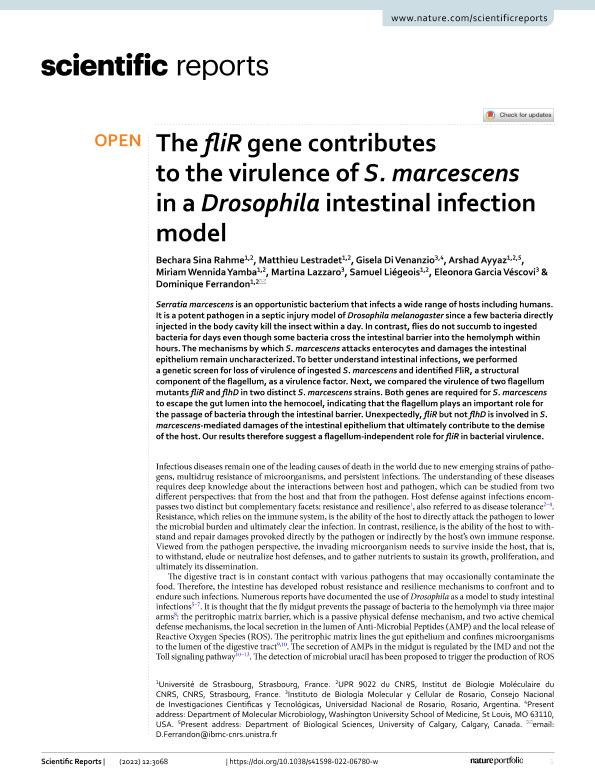Artículo
The fliR gene contributes to the virulence of S. marcescens in a Drosophila intestinal infection model
Sina Rahme, Bechara; Lestradet, Matthieu; Di Venanzio, Gisela Andrea ; Ayyaz, Arshad; Wennida Yamba, Miriam; Lazzaro, Martina
; Ayyaz, Arshad; Wennida Yamba, Miriam; Lazzaro, Martina ; Liégeois, Samuel; Garcia Vescovi, Eleonora
; Liégeois, Samuel; Garcia Vescovi, Eleonora ; Ferrandon, Dominique
; Ferrandon, Dominique
 ; Ayyaz, Arshad; Wennida Yamba, Miriam; Lazzaro, Martina
; Ayyaz, Arshad; Wennida Yamba, Miriam; Lazzaro, Martina ; Liégeois, Samuel; Garcia Vescovi, Eleonora
; Liégeois, Samuel; Garcia Vescovi, Eleonora ; Ferrandon, Dominique
; Ferrandon, Dominique
Fecha de publicación:
02/2022
Editorial:
Nature
Revista:
Scientific Reports
ISSN:
2045-2322
Idioma:
Inglés
Tipo de recurso:
Artículo publicado
Clasificación temática:
Resumen
Serratia marcescens is an opportunistic bacterium that infects a wide range of hosts including humans. It is a potent pathogen in a septic injury model of Drosophila melanogaster since a few bacteria directly injected in the body cavity kill the insect within a day. In contrast, flies do not succumb to ingested bacteria for days even though some bacteria cross the intestinal barrier into the hemolymph within hours. The mechanisms by which S. marcescens attacks enterocytes and damages the intestinal epithelium remain uncharacterized. To better understand intestinal infections, we performed a genetic screen for loss of virulence of ingested S. marcescens and identified FliR, a structural component of the flagellum, as a virulence factor. Next, we compared the virulence of two flagellum mutants fliR and flhD in two distinct S. marcescens strains. Both genes are required for S. marcescens to escape the gut lumen into the hemocoel, indicating that the flagellum plays an important role for the passage of bacteria through the intestinal barrier. Unexpectedly, fliR but not flhD is involved in S. marcescens-mediated damages of the intestinal epithelium that ultimately contribute to the demise of the host. Our results therefore suggest a flagellum-independent role for fliR in bacterial virulence.
Palabras clave:
Serratia
,
FliR
,
Drosophila
,
virulence
Archivos asociados
Licencia
Identificadores
Colecciones
Articulos(IBR)
Articulos de INST.DE BIOLOGIA MOLECULAR Y CELULAR DE ROSARIO
Articulos de INST.DE BIOLOGIA MOLECULAR Y CELULAR DE ROSARIO
Citación
Sina Rahme, Bechara; Lestradet, Matthieu; Di Venanzio, Gisela Andrea; Ayyaz, Arshad; Wennida Yamba, Miriam; et al.; The fliR gene contributes to the virulence of S. marcescens in a Drosophila intestinal infection model; Nature; Scientific Reports; 12; 1; 2-2022; 1-10
Compartir
Altmétricas



